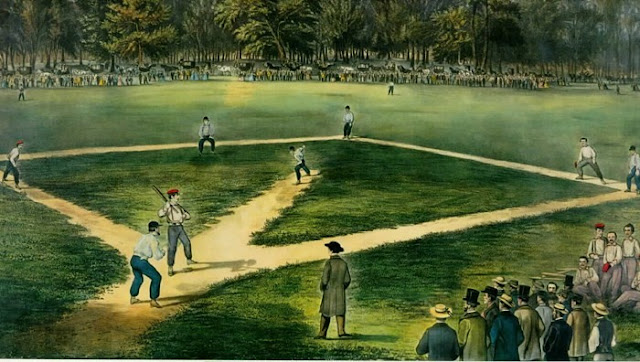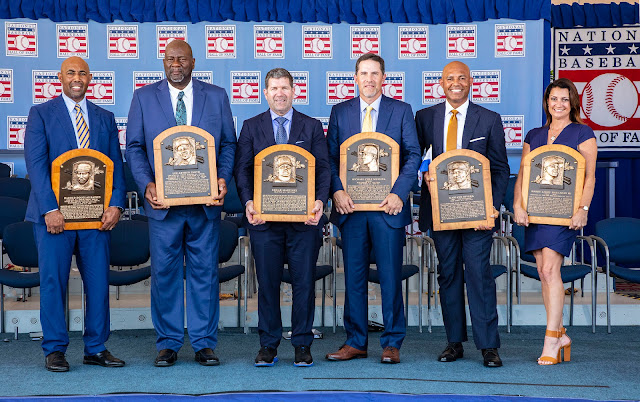With
local boosters licking their chops
and a somewhat embarrassed Major League
Baseball trying desperately to hold on to a ridiculous origin legend for the game saddled on them by the Mills Commission of 1908, the National Baseball Hall of Fame opened
its doors in beautiful but un-bustling Cooperstown,
New York on June 12, 1939.
The
pedigree of the National Pastime was
somewhat murky. Everyone knew
that it grew out of ball, bat, and tag games like Rounders
and Townball which had been played
on village greens since at least the
turn of the 19th Century. It was assumed to be related in some way to Cricket, the English national game which began taking hold in big American cities with the establishment
of clubs of well-heeled sportsmen. The
connection to Cricket, and even to Rounders, another game of English origins,
offended the sense of cocky jingoism
that accompanied the coincidental rise of baseball and America as a muscular
new world power in the later half of
the century.
If
the paths of evolution were befogged in the mists of time, the actual beginning
of modern baseball was not, and plenty of people knew it. The game as we know it came into being with
the formation of the New York Knickerbockers
founded on September 23, 1845. It
was one of several amateur sporting clubs made up mostly of young clerks playing bat and ball games to a
variety of rules. Alexander Cartwright and other members hammered out the Knickerbocker Rules, the first ever published. The adoption of these rules by other clubs
made games between squads of rival clubs possible without long negotiations
over field or day rules.
The
first inter-club game under these
rules was played at Elysian Fields
in Hoboken, New Jersey on June 19, 1846.
The Knickerbockers, by the way, lost to a club called the New York Nine. But it was pretty clearly THE first game.
By
the onset of the Civil War baseball
was being played by clubs adopting the rules throughout the Northeast, Mid-West, and Upper South, although various other
versions were still played locally in small towns and villages.
Many
a lad packed his bat and ball with his kit when reporting for duty in the Union Army. Baseball games enlivened
the deadly boredom of camp life between episodes of unimaginable horror
in the big battles of the war.
Young
Abraham Mills—no known relation to
my mother’s family—of the 5th New York
Volunteers—Duryée’s Zouaves—participated
in one notable game on Christmas
Eve of 1862 against members of other regiments before 40,000 troops camped
at Hilton Head Island, South Carolina.
Mills
returned from the war as a second lieutenant, completed law school
and set off on a distinguished career.
But he kept his hand in baseball as the player manager of the amateur
Olympic Base Ball Club in Washington,
D.C. Eventually his legal and
business connections and baseball experience secured him the Presidency of the National League.
In
1908 the former executive was put in charge of a special commission charged
with investigating the origins of the game.
Privately it was understood that he was to discover a uniquely American
pedigree un-besmirched by close association to British games. The Mills Commission did not work very
hard or very diligently.
On
the strength of a claim in one letter from a Colorado mining engineer,
Abner Graves who claimed to have
witnessed the first game played by Abner
Doubleday, a future Union Army general, and students of the Otsego Academy and Green’s Select School in Cooperstown in 1839. Despite numerous inconsistencies in
the story, the Commission declared to the world that Doubleday was the founder
and Cooperstown the cradle of baseball.
That
was their official story, and they were sticking with it, even as mounting
evidence year by year undercut the claim.
Cooperstown
was a once thriving town off the beaten track in central New York State. Near-by Lake
Otsego is the source of the Susquehanna
River. Its other connection to fame
was that it had been platted from a claim by the father of writer James Fenimore Cooper. Once the center of a hops growing region, it had been hit hard first by Prohibition and then by the Depression which had cut deeply into a summer resort business.
Stephen Carlton Clark, whose family had
made a fortune as co-founders of the Singer Sewing Machine Company and who had extensive holding in the
town, including half-empty resort hotels began scheming to find some way to
boost tourism. He realized that the
Doubleday connection was just what he needed.
He
began promoting the idea of a Hall of Fame in his hometown in the mid-1930s. Finally securing the blessing of Major
League Baseball, he launched a well-publicized national campaign to
elect the first members of the Hall while preparing his building in Cooperstown.
On
January 29, 1936 the first “class” was elected
And quite a line-up it was—Ty
Cobb, Babe Ruth, Honus Wagner, Christy Mathewson, and Walter
Johnson. With the standards for on field performance—not personal behavior—set so high, no
subsequent class would be admitted without controversy
and argument.
On
the strength of those names, particularly Ruth, who had only recently retired
and was still the Sultan of Swat to
well-heeled Yankee fans for whom the
tedious trip to Cooperstown was not quite so inconvenient, Clark finished his
shrine and launched it to great hoopla.
It
was an even greater goldmine than Clark ever imagined.
Currently
there are 333 elected members of the Hall including former MLB players, Negro leagues (now recognizing those organizations as Big Leagues), managers, umpires, and pioneers, executives, and organizers. In addition sportswriters
and broadcasters are also honored as
are collectively the members of the All-American
Girls Professional Baseball League.
This
year there will be no players voted on by sportswriters inducted for the first
time since 2013. No player quite made
the required cut despite the presence of at least three who would ordinarily be
shoe-ins—pitchers Curt Schilling, Roger Clemens, and intimidating
slugger Barry Bonds. But all of
them, like many top players of their era, have been tainted to one degree or
another steroid use which a significant portion of the baseball
writers currently feel should be disqualifying.
There
will, however, be inductees honored.
2020 additions to the Hall—Derek Jeter, Larry Walker, Ted
Simmons, and the late Marvin Miller, the controversial Executive
Director of the Major League Baseball Players Association (MLBPA)from
1966 to 1982. Believe me, team owners and league executives hate that last selection
and fought it for years. had their ceremonies canceled last summer by
the Coronavirus pandemic.
The
2020 cancelation and the general Covid-19 travel shut down was a huge economic
blow to Cooperstown, the Hall, and the Clark family. With no new inductees the traditional Awards
Presentation will remain an indoor, television-only event, Saturday,
July 24. There will, however, be an induction
ceremony in September with very limited seating at the Clark Sports Center which
has hosted it outside on the lawn since 1992. But far fewer than the usual crowds which approached
or surpassed 50,000 at five of the last six ceremonies from 2014-2019 will be
on hand.
Before
the pandemic about 315,000 fans annually made the still inconvenient pilgrimage
to what is now considered a reverential shrine.
With a full 2021 season reviving enthusiasm for the National Pass
Time, and the public eager to resume traveling, those numbers may well be
exceeded next year.
Decedents of the Clark
family certainly hope so. They still sit
on the Board and own just about all the available accommodations in town. They
are very good at counting money.
Like
a Muslim Hajj, very devoted baseball fan is expected to make the
pilgrimage at least once in his or her lifetime. I haven’t met that holy obligation yet.
Contributions to the cause will be gratefully accepted.





No comments:
Post a Comment